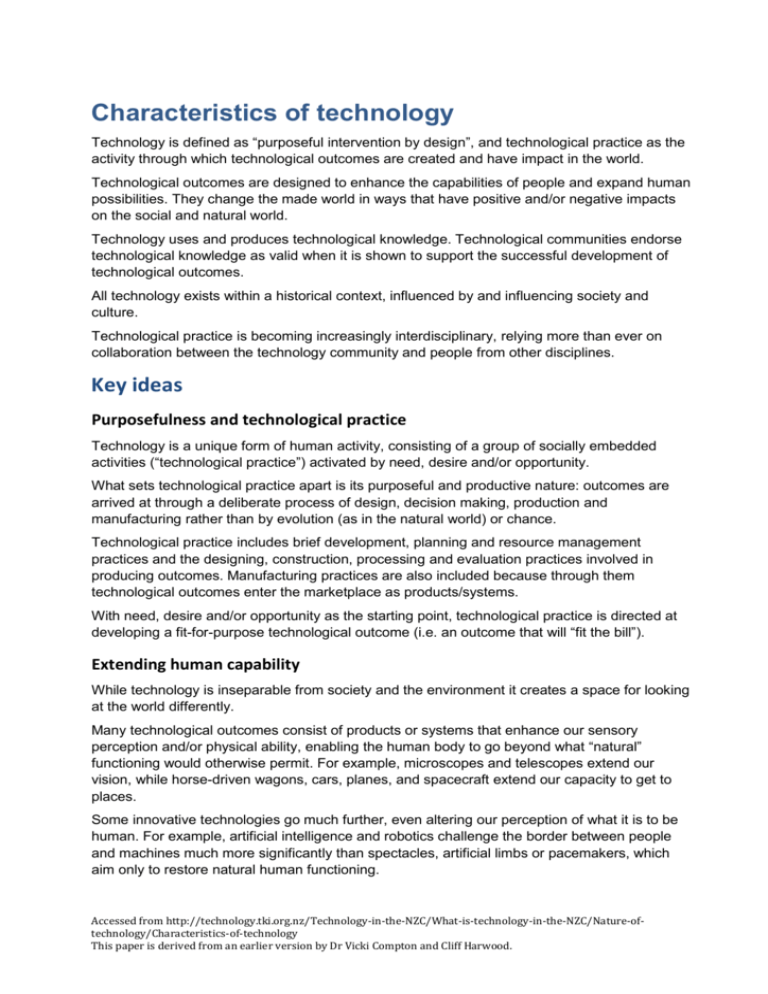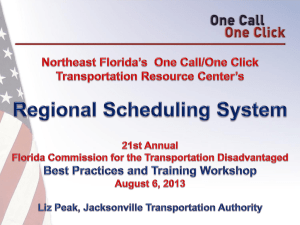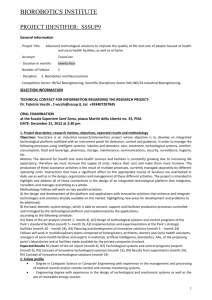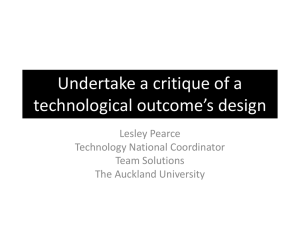Characteristics of technology: Key ideas
advertisement

Characteristics of technology Technology is defined as “purposeful intervention by design”, and technological practice as the activity through which technological outcomes are created and have impact in the world. Technological outcomes are designed to enhance the capabilities of people and expand human possibilities. They change the made world in ways that have positive and/or negative impacts on the social and natural world. Technology uses and produces technological knowledge. Technological communities endorse technological knowledge as valid when it is shown to support the successful development of technological outcomes. All technology exists within a historical context, influenced by and influencing society and culture. Technological practice is becoming increasingly interdisciplinary, relying more than ever on collaboration between the technology community and people from other disciplines. Key ideas Purposefulness and technological practice Technology is a unique form of human activity, consisting of a group of socially embedded activities (“technological practice”) activated by need, desire and/or opportunity. What sets technological practice apart is its purposeful and productive nature: outcomes are arrived at through a deliberate process of design, decision making, production and manufacturing rather than by evolution (as in the natural world) or chance. Technological practice includes brief development, planning and resource management practices and the designing, construction, processing and evaluation practices involved in producing outcomes. Manufacturing practices are also included because through them technological outcomes enter the marketplace as products/systems. With need, desire and/or opportunity as the starting point, technological practice is directed at developing a fit-for-purpose technological outcome (i.e. an outcome that will “fit the bill”). Extending human capability While technology is inseparable from society and the environment it creates a space for looking at the world differently. Many technological outcomes consist of products or systems that enhance our sensory perception and/or physical ability, enabling the human body to go beyond what “natural” functioning would otherwise permit. For example, microscopes and telescopes extend our vision, while horse-driven wagons, cars, planes, and spacecraft extend our capacity to get to places. Some innovative technologies go much further, even altering our perception of what it is to be human. For example, artificial intelligence and robotics challenge the border between people and machines much more significantly than spectacles, artificial limbs or pacemakers, which aim only to restore natural human functioning. Accessed from http://technology.tki.org.nz/Technology-in-the-NZC/What-is-technology-in-the-NZC/Nature-oftechnology/Characteristics-of-technology This paper is derived from an earlier version by Dr Vicki Compton and Cliff Harwood. Technological and other outcomes Not all technological practice results in a completed technological outcome (a fully realised and implemented product or system). Other outcomes include a brief that describes an outcome, a feasibility argument, design ideas for parts of an outcome, conceptual designs for a product or system, a model, or a prototype that has yet to be trialled in situ. While these are not technological outcomes, they are nevertheless all valid outcomes of technological practice. A socially embedded activity Technology is a socially embedded human activity; every technological outcome is designed in and for a particular time and physical and social location. This characteristic means that the social world of culture, politics, and ideologies, together with the natural world, collectively influences technological development and developments. This influence is however a two-way street: through its creation of the made world, technology has a profound and complex influence on the social and natural world. Technological determinists argue that technology drives social change; those from a “social shaping” perspective argue that society drives technological development; those who espouse a socio-technological perspective argue that technology and society are intertwined in myriad and often difficult-to-determine ways. Creative and critical thinking, functional and practical reasoning To develop and explore initial design concepts, refine and select those that are feasible, then realise them as technological outcomes, technologists need both creative and critical thinking. Using a combination of informed creativity and critical reflection, they can learn from the past, push boundaries, and imagine future possibilities. Reasoned decision making, which depends on both functional and practical reasoning, underpins all technology. Functional reasoning focuses on how and why things work; practical reasoning focuses on what should or ought to be done – in other words, on what can be justified in terms of social and ethical standards or norms. This “normative” reasoning is concerned with what is good or bad and what is right or wrong. It reflects the social and cultural mores and values of the particular society, environment, and era. Practical reasoning is necessary if people are to view technology as beneficial for humanity, and not a law unto itself. Expect the unexpected While good technological practice is based on the best available knowledge and on reasoned decision making, unforeseen issues always surface during practice and/or implementation. Sustainability and/or quality control issues not apparent during the development of a one-off outcome may surface when manufacturing begins, or unexpected problems may occur when a technological product and/or system is transferred to a setting that it was not designed for. This has happened when aid programmes have attempted to transplant First World technological outcomes into Third World countries (for example, solar ovens ended up being used as containers when introduced into a country where cooking over fire was the norm). Accessed from http://technology.tki.org.nz/Technology-in-the-NZC/What-is-technology-in-the-NZC/Nature-oftechnology/Characteristics-of-technology This paper is derived from an earlier version by Dr Vicki Compton and Cliff Harwood. Different impacts While all technology seeks to enhance human capability, not everyone shares the benefits of these enhancements (this is obviously true of war technologies, whose sole purpose is to put whole groups of people at a disadvantage). This means that, when seeking to understand technology, its power, and its limitations, we must recognise that technological practices and outcomes are of different value to different people, and in different places and times. The worth of a technological development needs to be established by critical analyses that take into account historical precedents and a multiplicity of social, cultural, and political perspectives. Disciplinary knowledge Technology is a discipline in its own right, with its own body of knowledge and skills, but it is also interdisciplinary in nature, drawing widely on knowledge and skills from other disciplines (for example, science, mathematics, art, philosophy, psychology, and ethics). It is important to understand what is distinctive about technological knowledge so that it can be used in conjunction with other specialist knowledge in mutually supportive and enhancing ways. Current educational theory suggests that all knowledge is socially constructed as people interact with each other and the world. Within this theoretical framework, technology and other disciplines can be viewed as bodies of shared understandings that grow and evolve as new knowledge is validated by the acknowledged experts. What is distinctive about technology is that when new knowledge is being evaluated for possible acceptance, what matters is whether it supports the successful functioning of a technological outcome. This is different from science, where the focus is on whether it provides the most successful explanation for a phenomenon. These different focuses reflect the fundamentally different purposes of the two disciplines: science exists to explain the world; technology, to intervene in the world. Codified knowledge Aspects of technological knowledge are often codified (translated into rules or regulations) when experts consider they have sufficient evidence to warrant it. These rules or regulations may consist of codes of practice, codes of ethics, intellectual property codes, codes of standards, acceptable tolerances, etc. Codified knowledge is a safeguard for technologists, reminding them of their responsibilities. Also, it gives them access to knowledge and procedures that have been tested over time and shown to support successful technological development. In these ways, codified knowledge puts constructional, processing, manufacturing, and ethical and/or legal compliance constraints on technological developments. Collaboration Technology is becoming increasingly interdisciplinary, so successful outcomes typically require a great deal of collaboration between people and across disciplines. For this to happen technologists need to recognise that different disciplines have different bodies of knowledge, and know which disciplines to involve in a particular context. Interdisciplinary collaboration provides exciting opportunities for technologists to work at the boundaries of established fields, but in such situations there will sometimes be little or no Accessed from http://technology.tki.org.nz/Technology-in-the-NZC/What-is-technology-in-the-NZC/Nature-oftechnology/Characteristics-of-technology This paper is derived from an earlier version by Dr Vicki Compton and Cliff Harwood. codified technological knowledge to guide practice, in which case the scope for tension and unknown and unintended consequences is increased. Collaboration requires technologists to engage in constructive debate, set priorities based on extensive functional modelling and multiple perspectives, and employ sophisticated strategies for decision making. Accessed from http://technology.tki.org.nz/Technology-in-the-NZC/What-is-technology-in-the-NZC/Nature-oftechnology/Characteristics-of-technology This paper is derived from an earlier version by Dr Vicki Compton and Cliff Harwood.







